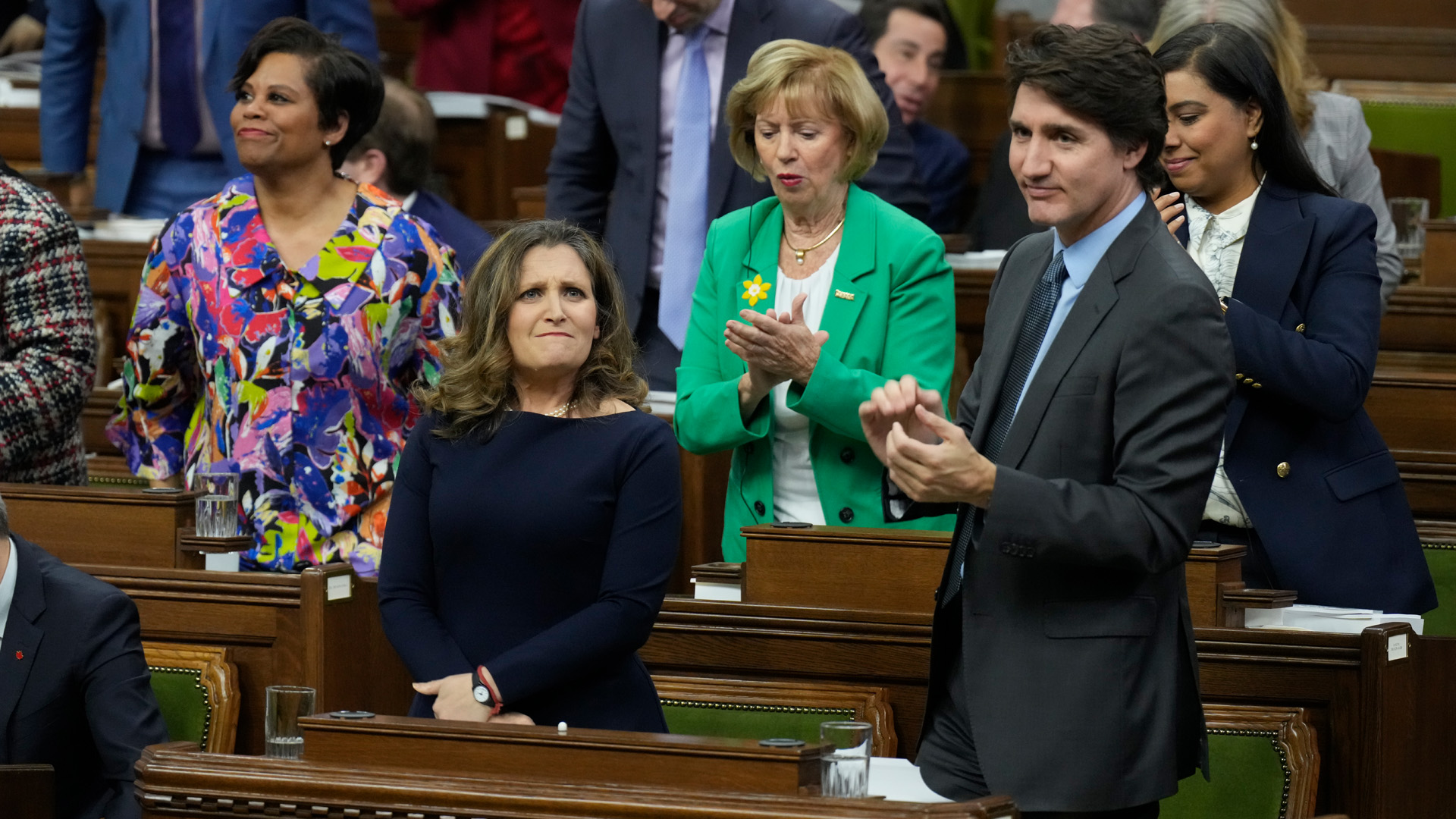
(Version française disponible ici)
In her economic update last autumn, federal Finance Minister Chrystia Freeland set three main objectives for the 2024 budget.
The first was to keep the announced deficit in 2023-2024 at or below the 2023 budget forecast of $40.1 billion.
The second was to lower the debt-to-GDP ratio in 2024-2025 compared with the fall economic statement (42.7 per cent), and to keep it on a downward trajectory thereafter.
The third was to continue the decline in the deficit-to-GDP ratio in 2024-2025, and then to keep it below 1 per cent of GDP in 2026-2027 and beyond.
In her recent budget, the minister respects each of these objectives: the deficit for 2023-2024 is $40 billion; the projected debt-to-GDP ratio for 2024-2025 is 41.9 per cent; and the deficit-to-GDP ratio falls by 0.1 per cent in 2024-2025, to 0.9 per cent in 2026-2027, and declines further thereafter.
Increased interventionism
However, the fact that the budget targets are being met masks increased interventionism, leading to $57.9 billion in new initiatives between 2023-2024 and 2028-2029. Although the minister has identified additional sources of revenue (to which we will return shortly), the fact remains that the cumulative deficits over the entire period will increase by $10.3 billion.
The conclusion is that this budget is far from restrictive. Between 2023-2024 and 2024-2025, federal revenues will rise by 7.0 per cent, program spending by 6.7 per cent, and interest on the debt by almost 15 per cent.
Interest payments on the debt have risen significantly. After a low of $20.4 billion in 2020-2021, they are estimated to reach $54.1 billion in 2024-2025 and $64.3 billion in 2028-2029. It means that for the current year, Ottawa must now devote the equivalent of all the revenue from the GST to pay interest on the debt.
Capital gains tax to the rescue
The finance minister will be seeking additional revenue mainly by reducing the preferential treatment given to capital gains. The impact of this change alone on corporations, trusts and individuals will exceed $19 billion over 5 years.
Since the Liberals came to power in 2015, many had expected such a tightening, not least because the marginal tax rate on a capital gain was lower than the highest marginal tax rate on eligible dividends. This encouraged tax planning aimed at converting dividends into capital gains. Some of these have proved to be uncertain, creating uncertainty when challenged by the Canada Revenue Agency.
Historically, capital gains have always received preferential treatment. Such treatment is often presented as recognition of the effect of inflation on long-term capital gains, or as a way of rewarding risk-taking. The federal government explicitly recognised this when it introduced the Canadian entrepreneurs’ incentive in the last budget (which will be explained later).
Prior to 1972, capital gains were not taxed in Canada. It was the Benson budget of 1971 that reformed the definition of income to include up to 50 per cent of capital gains. In practice, this meant that half of the capital gain was added to income and taxed at the applicable rate. The other half of the capital gain remained exempt from tax, representing an advantage of 50 per cent.
This proposal followed on from the Royal Commission on Taxation (the Carter commission), which recommended, however, that it be included in its entirety under the principle of “a buck is a buck is a buck”, which essentially means that although income can be earned in a variety of ways, it is ultimately income, and therefore all income should be taxed in the same way.
For more than fifty years, the advantage has varied between 25 per cent and 50 per cent, as shown in table 1.
As an indication, when the capital gains inclusion rate was increased effective January 1, 1988 and January 1, 1990, the announcement was made in June 1987 (when the tax reform was announced), giving taxpayers time to adjust. Conversely, when the capital gains inclusion rate was reduced in 2000, the announcements took effect the same day.
The 2024 budget reduces the preferential treatment given to capital gains to 33.33 per cent. In other words, two-thirds of the capital gain (66.67 per cent) will now be added to taxable income. For corporations, this change affects all capital gains, but for individuals, it only affects the portion exceeding $250,000 of annual capital gains. This $250,000 exemption is determined after taking into account capital losses. The new treatment applies from 25 June 2024, giving taxpayers time to organise their affairs before the measure comes into force.
For their part, the provinces have always had the same partial inclusion rate for capital gains as that applied by the federal government. Quebec has decided to follow suit, representing potential additional tax revenue of $3 billion over five years.
Real estate assets
Many people are concerned about how the change will affect gains on the sale of property such as rental property or a second home. Taxpayers can continue to claim the exemption for the principal residence, which means that the gain remains entirely tax-free. Furthermore, in the case of couples where the secondary residence is 50 per cent owned by a spouse, each of them is entitled to the $250,000 exemption threshold. The capital gain on the secondary residence must therefore exceed $500,000 before the recent changes have a negative effect on a couple.
Presumed disposition at death
Apart from certain transfers of property between spouses that have no tax consequences at the time of death, the deceased is taxed on the capital gain accumulated at the time of death. Once again, the $250,000 exemption threshold applies, and only the excess is subject to the 66.67 per cent inclusion rate.
New support for small businesses
To avoid criticism of the effect that the increase in the capital gains inclusion rate could have on entrepreneurship, the minister of finance is increasing the lifetime capital gains exemption by 25 per cent to compensate for the increase in the inclusion rate. The new lifetime limit will reach $1.25 million as of June 25, 2024, and will be indexed to inflation as of 2026.
In addition, from Jan. 1, 2025, a new Canadian entrepreneur incentive will be introduced for entrepreneur-founders. This involves a reduction in the tax rate on capital gains when shares are sold. On the qualifying gain – amounts above the $1.25 million covered by the lifetime capital gains exemption – the inclusion rate is half of the current rate (i.e. 33.33 per cent instead of 66.67 per cent). The lifetime limit will be phased in by increments of $200,000 per year, up to a maximum of $2 million on January 1, 2034.
The more advantageous treatment will therefore eventually apply to a capital gain of $3.25 million arising from the sale of shares in a company, a significant improvement for those who qualify.
A more neutral tax regime
At current tax rates in Quebec, the difference between top marginal rates is almost 27 percentage points compared with ordinary income such as a salary (26.7 per cent versus 53.3 per cent), or just over 13 percentage points compared with dividends (26.7 per cent versus 40.0 per cent). Reducing the advantage associated with capital gains from 50 per cent to 33.33 per cent will reduce the gap and ensure greater symmetry in the tax treatment of dividends and capital gains. As a result, the marginal rates would be more uniform (35.5 per cent for capital gains versus 40.0 per cent for eligible dividends). The results are similar in Ontario.
Aside from assessing what this major change will bring in terms of taxation, we must consider the context of the current and future budget imbalances in Ottawa and the provinces. Both must at least consider ways to raise revenue. Ottawa’s move is also a benefit to the provinces, which are all likely to stay in lockstep on capital gains. To name one example, Chrystia Freeland’s budget has helped Quebec Finance Minister Eric Girard’s plan to return to a balanced budget.









